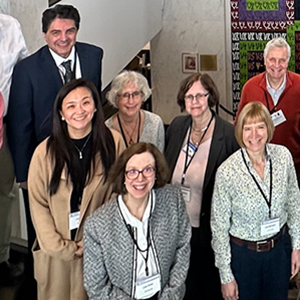Scientists now know the early stage of rheumatorid arthritis may represent a key window to intervene in the disease process, according to V. Michael Holers, M.D., Smyth Professor of Rheumatology and Professor of Medicine and Immunology at the University of Colorado School of Medicine, and President of the Rheumatology Research Foundation.

At the NIEHS Distinguished Lecture held Dec. 13, Holers explained how scientists once thought that some autoimmune diseases, such as rheumatoid arthritis, were caused by a viral infection and had a very rapid period of development. Now, he says, researchers believe that a combination of genetic and environmental risk factors increase the likelihood of developing an autoimmune disease over the course of a lifetime, and that the process is underway for years before clinical signs develop.
In 2001, Holers co-founded a national effort, the Studies of the Etiologies of Rheumatoid Arthritis (SERA) registry, to understand the early development of rheumatoid arthritis. The effort expanded research into the biological drivers of the disease and showed that certain autoantibodies can precede its clinical development. Today, Holers and others seek to uncover ways to interrupt the disease process before clinical signs and symptoms appear.
“Environmental factors are modifiable, and if you are able to eliminate one of those factors, there is potential to stop the disease from developing or to keep it from developing as severely,” he said.
Known risk factors
Environmental exposures can put individuals at higher risk of developing rheumatoid arthritis, according to Holers. Those exposures include hormonal and reproductive factors such as oral contraceptive use as well as behavioral factors like smoking, proximity to air pollution, and diet.
Inhaling silica during mining activities, for example, could lead to an increased risk of developing rheumatoid arthritis, whereas eating more foods with omega-3 fatty acids could lower the risk. Altering environmental exposures could potentially slow or stop the development of the disease, particularly before its onset, he said.
“Holers is a thought leader in the area of preclinical and early rheumatoid arthritis,” said Lisa Rider, M.D., head of the NIEHS Environmental Autoimmunity Group. “He has enabled the field to shift the paradigm so we can better understand environmental factors and biological mechanisms that influence initiation of the disease.” Rider co-hosted the lecture with Frederick Miller, M.D., Ph.D., NIH Scientist Emeritus and former head of the Environmental Autoimmunity Group.
Pathway to intervention
Holers’s research focuses on the development of the disease prior to diagnosis, a stage called pre-rheumatoid arthritis. During this early stage, he has examined the role of autoantibodies, which are antibodies that mistakenly attack a person’s own tissues and organs.
In one study, Holers and his collaborators collected blood samples from active-duty military personnel when they began service and then every two years after. They analyzed samples from people who were eventually diagnosed with rheumatoid arthritis as well as a control group of people who did not develop any symptoms. The researchers found those who developed the disease had higher concentrations of autoantibodies in their blood up to 17 years prior to diagnosis.
“The goal is to develop a health care approach where you can identify people in that risk period, and intervene before they develop arthritis,” he said.
(Susan Cosier is a contract writer for the NIEHS Office of Communications and Public Liaison.)









